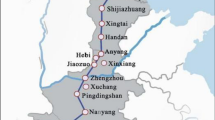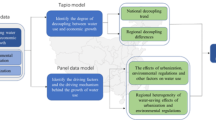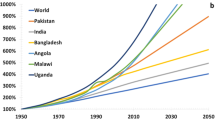Abstract
Achieving equality in water usage is part of the sixth goal of the 2030 Agenda for Sustainable Development. A comprehensive understanding evolution of inequality in water use and the driving factors behind the inequality can facilitate to implement equality in water consumption. In this work, the inequality index was used to measure China’s water consumption inequality from 2004 to 2018 and the decomposition technique was used to decompose the status of inequality and the evolution of inequality. The results show the inequality in its water consumption was not reduced obviously despite China’s rapid economic growth. There were 38.71% of provinces in China whose per capita water consumption was greater than the national average, mainly in the western region. For the three regions of China, the intraregional inequality was much greater than the interregional inequality. The western index was the largest and the eastern was the smallest. Among the factors that cause the inequality in water consumption, no one factor has been dominant at all times. Moreover, the effects of different factors changed over time. It is almost impossible to reduce inequality in water consumption through policy adjustment to several factors. China’s example show that economic development cannot reduce the inequality in water consumption. More targeted policies and more efforts are required to reduce the inequality in water consumption.
Graphical abstract










Similar content being viewed by others
Data availability
The datasets used and/or analyzed during the current study are available from the corresponding author on reasonable request.
References
Alun G, Yue Z, Bolin P (2017) Relationship between industrial water use and economic growth in china: insights from an environmental Kuznets Curve. Water 9:556
Ang BW, Choi K-H (1997) Decomposition of aggregate energy and gas emission intensities for industry: a refined Divisia index method. Energy J 18:59–73
Bai T, Sun C (2018) Regional inequality and factor decomposition of the per capita grey water footprint in China. Acta Ecol Sin 38:6314–6325
Bai C, Feng C, Yan H, Yi X, Chen Z, Wei W (2020) Will income inequality influence the abatement effect of renewable energy technological innovation on carbon dioxide emissions? J Environ Manag 264:110482
Bianco V, Cascetta F, Marino A, Nardini S (2019) Understanding energy consumption and carbon emissions in Europe: a focus on inequality issues. Energy 170:120–130
Chen X (2018) Analysis on the potential and countermeasures of water conservation in chinese cities. The journal quality of goods 000:279–280
Chen J, Xu C, Cui L, Huang S, Song M (2019a) Driving factors of CO2 emissions and inequality characteristics in China: a combined decomposition approach. Energy Econ 78:589–597
Chen L, Xu L, Yang Z (2019b) Inequality of industrial carbon emissions of the urban agglomeration and its peripheral cities: a case in the Pearl River Delta, China. Renew Sust Energ Rev 109:438–447
Duro Moreno JA, Teixidó Figueras J, Padilla E (2017) The causal factors of international inequality in co2 emissions per capita: a regression-based inequality decomposition analysis. Environ Resour Econ 67:683–700
Feng Y (2011) Discussion on the development and utilization of water resources in China. Light Industrial Design 000:241–241
Galvin R (2019) Letting the Gini out of the fuel poverty bottle? Correlating cold homes and income inequality in European Union countries. Energy Res Soc Sci 58:101255
Gu S, Fu B, Thriveni T, Fujita T, Ahn JW (2019) Coupled LMDI and system dynamics model for estimating urban CO2 emission mitigation potential in Shanghai, China. J Clean Prod 240:118034
Han M, Lao J, Yao Q, Zhang B, Meng J (2020) Carbon inequality and economic development across the Belt and Road regions. J Environ Manag 262:110250
Hao T (2019) Research on the relationship between environmental equity and economic growth in China and the decomposition of influencing factors. Nanjing University
Huang Z, Duan H (2020) Estimating the threshold interactions between income inequality and carbon emissions. J Environ Manag 263:110393
Jorgenson A, Schor J, Huang X (2017) Income inequality and carbon emissions in the United States: a state-level analysis, 1997–2012. Ecol Econ 134:40–48
Lei Y, Su L (2016) Spatial Analysis of the Regional Differences of Water Footprint Intensity in China. Ecol Econ 032:29–35
Lei HJ, Li CJ, Xia XF, Xi BD (2012) Decomposing the influencing factors of China’s industrial wastewater discharges using LMDI I method. Adv Mater Res 518-523:2089–2098
Li X (2015) Research on the impact of financial structure on the upgrading of industrial structure. Tianjin University of Finance and Economics
Li R, Jiang R (2020) Investigating effect of R&D investment on decoupling environmental pressure from economic growth in the global top six carbon dioxide emitters. Sci Total Environ 740:140053
Li Y, Wang S, Chen B (2019) Driving force analysis of the consumption of water and energy in China based on LMDI method. Energy Procedia 158:4318–4322
Liang J, Zhang LX (2010) The measure and analysis on the spatial inequality of urban energy consumption in China based on Theil index. China Popul Resour Environ 20:85–88
Liu T (2017) Game analysis on the efficiency and evolution of agricultural water use in provinces. Water Saving Irrigation 9:97–100
Liu T, Pan W (2017) The regional inequity of CO2 emissions per capita in China. Int J Econ Finance 9:7
Lu S, Jiang H, Liu Y, Huang S (2017) Regional disparities and influencing factors of average CO2 emissions from transportation industry in Yangtze River Economic Belt. Transp Res Part D: Transp Environ 57:112–123
Nations U (2015) Transforming our world: the 2030 agenda for sustainable development General Assembley 70 session.https://sustainabledevelopment.un.org/post2015/transformingourworld
Pakrooh P, Hayati B, Pishbahar E, Nematian J, Brännlund ER (2020) Focus on the provincial inequalities in energy consumption and CO2 emissions of Iran’s agriculture sector. Sci Total Environ 715:137029
Pan X, Wang H, Wang Z, Lin L, Zhang Q, Zheng X, Chen W (2019) Carbon palma ratio: a new indicator for measuring the distribution inequality of carbon emissions among individuals. J Clean Prod 241:118418
Rao ND, Min J (2018) Less global inequality can improve climate outcomes. Wiley Interdiscip Rev Clim Chang 9:2
Remuzgo L, Sarabia JM (2015a) A general factorial decomposition of the second Theil index of inequality with applications in environmental economics. Econ Bull 35:1369–1378
Remuzgo L, Sarabia JM (2015b) International inequality in CO2 emissions: a new factorial decomposition based on Kaya factors. Environ Sci Pol 54:15–24
Rojas-Vallejos J, Lastuka A (2020) The income inequality and carbon emissions trade-off revisited. Energy Policy 139:111302
Schaffartzik A, Duro JA, Krausmann F (2019) Global appropriation of resources causes high international material inequality – growth is not the solution. Ecol Econ 163:9–19
Sinha A (2017) Inequality of renewable energy generation across OECD countries: a note. Renew Sust Energ Rev 79:9–14
Statistics NBo (2004-2018a) China Statistical Yearbook China Statistics Press
Statistics NBo (2004-2018b) Statistical Yearbooks by Province (31 Provinces) China Statistics Press
Su L (2017) A spatial empirical study on regional differences and influencing factors of China’s water footprint intensity. South China University of Technology
Sun JW (1998) Changes in energy consumption and energy intensity: a complete decomposition model. Energy Econ 20:85–100
Sun JW, Ang BW (2000) Some properties of an exact energy decomposition model. Energy 25:1177–1188
Sun S, Fang C, Lv J (2017) Spatial inequality of water footprint in China: a detailed decomposition of inequality from water use types and drivers. J Hydrol 553:398–407
Sun C, Ma Q, Zhao L (2018) Analysis on the temporal and spatial evolution characteristics and convergence of water resources green efficiency in the three regions of east, central and west China. Geogr Sci Prog 037:901–911
Theil H (1967) Economics and information theory. North Holland, Amsterdam
Tomás M, López LA, Monsalve F (2020) Carbon footprint, municipality size and rurality in Spain: inequality and carbon taxation. J Clean Prod 266:121798
(UNICEF) UNCsF (2017) Progress on drinking water, sanitation and hygiene: 2017 Update and SDG Baselines
Wang X, Ma Z (2007) The appropriate is the best: awareness of Xinjiang wastewater treatment process selection. Water & Wastewater Information 3:14–16
Wang Q, Su M (2019) The effects of energy prices, urbanization and economic growth on energy consumption per capita in 186 countries. J Clean Prod 225:1017–1032
Wang Q, Su M (2020) Drivers of decoupling economic growth from carbon emission – an empirical analysis of 192 countries using decoupling model and decomposition method. Environ Impact Assess Rev 81:106356
Wang Q, Wang S (2020a) Is energy transition promoting the decoupling economic growth from emission growth? Evidence from the 186 countries. J Clean Prod 260:120768
Wang Q, Wang X (2020b) Moving to economic growth without water demand growth -- a decomposition analysis of decoupling from economic growth and water use in 31 provinces of China. Sci Total Environ 726:138362
Wang Q, Zhang F (2020) Does increasing investment in research and development promote economic growth decoupling from carbon emission growth? An empirical analysis of BRICS countries. J Clean Prod 252:119853
Wang S, Wang J, Fang C, Feng K (2019) Inequalities in carbon intensity in China: a multi-scalar and multi-mechanism analysis. Appl Energy 254:113720
Wang Y, Yan Q, Li Z, Baležentis T, Zhang Y, Gang L, Streimikiene D (2020) Aggregate carbon intensity of China’s thermal electricity generation: the inequality analysis and nested spatial decomposition. J Clean Prod 247:119139
Xiong H, Zhou Y (2019) An Analysis of Water Resources Pressure and Driving Forces in Anhui Province Based on LMDI-Three-Dimensional Water Footprint Model. Water Soil Conser Bull 39:194–203
Yao L, Zhang H, Zhang C, Zhang W (2018) Driving effects of spatial differences of water consumption based on LMDI model construction and data description. Clust Comput 22:6315–6334
Yao L, Xu J, Zhang L, Pang Q, Zhang C (2019) Temporal-spatial decomposition computing of regional water intensity for Yangtze River Economic Zone in China based on LMDI model. Sustain Comput-Infor 21:119–128
Zhang C, Zhang H, Gong Y (2014) China’s structural upgrading, technological progress and water consumption: based on the improved LMDI method. Resour Sci 036:1993–2002
Zhang C, Zhang H, Chen Q, Zhang W, Business SO, University H (2016) Factors influencing water use changes based on LMDI Methods. Resour Sci 38:1308–1322
Zhang C, Dong J, Lin L, Xuyou YU (2017) Influence factors for differences in regional water use based on LMDI method. J Econ Water Resour 35:71–75+82
Zhang S, Su X, Singh VP, Ayantobo OO, Xie J (2018) Logarithmic Mean Divisia Index (LMDI) decomposition analysis of changes in agricultural water use: a case study of the middle reaches of the Heihe River basin, China. Agric Water Manag 208:422–430
Acknowledgements
The authors would like to thank the editor and these anonymous reviewers for their helpful and constructive comments that greatly contributed to improving the final version of the manuscript. The author thanks the following funds for their support: National Natural Science Foundation of China (Grant No. 71874203), Humanities and Social Science Fund of Ministry of Education of China (Grant No.18YJA790081), Natural Science Foundation of Shandong Province, China (Grant No. ZR2018MG016).
Funding
This work is funded by the National Natural Science Foundation of China (Grant No. 71874203), the Humanities and Social Science Fund of Ministry of Education of China (Grant No.18YJA790081), and the Natural Science Foundation of Shandong Province, China (Grant No. ZR2018MG016).
Author information
Authors and Affiliations
Contributions
Qiang Wang: conceptualization; methodology; software; data curation; writing—original draft preparation; supervision; writing—reviewing and editing. Xiaowei Wang: methodology; software; investigation; writing—original draft; writing—reviewing and editing.
Corresponding author
Ethics declarations
Ethics approval and consent to participate
Not applicable
Consent for publication
Not applicable
Competing interests
The authors declare no competing interests.
Additional information
Responsible Editor: Baojing Gu
Publisher’s note
Springer Nature remains neutral with regard to jurisdictional claims in published maps and institutional affiliations.
Highlights
• Evaluate the water consumption inequality in China and 31 provinces in 2004–2018.
• A new decomposition Theil inequality index model is constructed based on LMDI.
• The status of inequality of per capita water consumption is decomposed into six indicators.
• The water consumption inequality in three regions of China is compared.
• Analyze the contribution of intraregional and interregional inequality to overall inequality.
Supplementary Information
ESM 1
(DOCX 21 kb)
Rights and permissions
About this article
Cite this article
Wang, Q., Wang, X. Does economic growth help reduce inequality of water consumption? Insight from evolution and drivers of inequality in water consumption in China. Environ Sci Pollut Res 28, 37338–37353 (2021). https://doi.org/10.1007/s11356-021-13243-8
Received:
Accepted:
Published:
Issue Date:
DOI: https://doi.org/10.1007/s11356-021-13243-8




